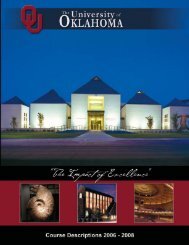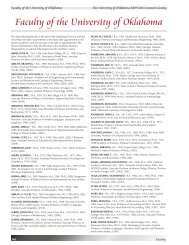ART - Catalog - University of Oklahoma
ART - Catalog - University of Oklahoma
ART - Catalog - University of Oklahoma
Create successful ePaper yourself
Turn your PDF publications into a flip-book with our unique Google optimized e-Paper software.
Atmospheric and Geographic Sciences (AGSC)<br />
The Uni ver sity <strong>of</strong> <strong>Oklahoma</strong> 2006-2008 Gen eral Cat a log<br />
3190 Topics in Astronomy. 1 to 3 hours. Prerequisite: permission <strong>of</strong><br />
instructor. May be repeated with change <strong>of</strong> subject matter; maximum<br />
credit nine hours. (F, Su)<br />
3990 Independent Study. 1 to 3 hours. Prerequisite: one course in general<br />
area to be studied; permission <strong>of</strong> instructor and department. May be<br />
repeated; maximum credit six hours. Contracted independent study for topic<br />
not currently <strong>of</strong>fered in regularly scheduled courses. Independent study<br />
may include library and/or laboratory research and field projects. (Sp, Su)<br />
G4303 Stellar Astrophysics. Prerequisite: 3113 or permission <strong>of</strong> instructor.<br />
Physics <strong>of</strong> stars: gas and radiation laws, stellar atmospheres and spectra,<br />
stellar interiors and evolution. (F)<br />
4990 Independent Study. 1 to 3 hours. Prerequisite: three courses in general<br />
area to be studied; permission <strong>of</strong> instructor and department. May be<br />
repeated; maximum credit six hours. Contracted independent study for<br />
topic not currently <strong>of</strong>fered in regularly scheduled courses. Independent<br />
study may include library and/or laboratory research and field projects. (F,<br />
Sp, Su)<br />
G5403 High-Energy Astrophysics. Prerequisite: 4303 or permission <strong>of</strong><br />
instructor. High-energy radiation processes in astronomy: synchrotron<br />
radiation, bremsstrahlung, inverse Compton-effect. New wavebands <strong>of</strong><br />
observation, UV, X-ray and gamma-ray astronomy. Radioastronomy:<br />
supernova remnants, pulsars, neutron stars. Radiogalaxies, active galactic<br />
nuclei, quasars. Theories <strong>of</strong> the origin <strong>of</strong> cosmic rays. (Irreg.)<br />
G5443 Galactic Astronomy. Prerequisite: 4303 or permission <strong>of</strong> instructor.<br />
Basic properties <strong>of</strong> galaxies are explored with special focus on the Milky<br />
Way. Topics include galaxy classification and morphology, stellar<br />
populations, clusters and kinematics, interstellar medium, distributions <strong>of</strong><br />
mass and light, spiral structure, chemical evolution, systemic rotation and<br />
galaxy mass, and distance-determining methods. (Irreg.)<br />
G5453 Extragalactic Astronomy and Cosmology. Prerequisite: 3113 or<br />
4303 or permission <strong>of</strong> instructor. Basic properties <strong>of</strong> stars. Review <strong>of</strong><br />
observational tools for extragalactic work. Stellar content and interstellar<br />
medium in normal galaxies. Introduction to the theory <strong>of</strong> Big Bang cosmology.<br />
Comparison <strong>of</strong> observational data to cosmological predictions. The<br />
extragalactic distance scale and the age <strong>of</strong> the universe. Large scale structure:<br />
galaxy clusters and superclusters. Active galaxies—radio galaxies and quasars.<br />
(Irreg.)<br />
G5463 Stellar Atmospheres. Prerequisite: 4303 or permission <strong>of</strong><br />
instructor. Local thermodynamic equilibrium. Radiative transfer, continuous<br />
absorption coefficient and model stellar atmospheres. Atomic and<br />
molecular spectroscopy and the quantitative analysis <strong>of</strong> stellar spectra.<br />
Atomic processes and departures from local thermodynamic equilibrium.<br />
Extended and expanding atmospheres, novae, supernovae. (Irreg.)<br />
G5473 Stellar Interiors. Prerequisite: 4303 or permission <strong>of</strong> instructor.<br />
Evolution and energy balance <strong>of</strong> stars including gravitational attraction,<br />
nucleosynthesis, radiative and convective energy, transport and<br />
equilibrium, construction <strong>of</strong> stellar models for pre-main sequence and<br />
main sequence stars, and the theory <strong>of</strong> giants and white dwarfs. (Irreg.)<br />
G5513 Interstellar Medium. Prerequisite: 4303 or permission. Processes<br />
in low-density media are explored, including the physics relevant to<br />
emission line objects such as HII and HI regions, molecular clouds, and<br />
active galaxies. Techniques for deriving chemical abundances are explored,<br />
as are interstellar absorption by gas and dust and radiation transfer. (Irreg.)<br />
G5900 Seminar in Astrophysics. Prerequisite: permission <strong>of</strong> instructor.<br />
May be repeated with change <strong>of</strong> subject matter; maximum credit nine<br />
hours. A research seminar devoted to the study <strong>of</strong> specialized topics in<br />
astronomy and astrophysics. Topics selected will reflect the interest <strong>of</strong> the<br />
instructor and students. (Irreg.)<br />
Atmospheric and Geographic<br />
Sciences (AGSC)<br />
2004 Evolution <strong>of</strong> the Earth System. Overview <strong>of</strong> the earth from a systems<br />
perspective. Draws on knowledge from all geosciences to explore<br />
interconnections and co-evolution <strong>of</strong> the solid earth, atmosphere, oceans,<br />
and living things. Evolution <strong>of</strong> the Earth’s climate over geologic time<br />
including the hydrologic cycle, carbon, cycle and “greenhouse effect”. Role<br />
living things play in the global environment. Extensive use <strong>of</strong> numerical<br />
models to explore structure and response <strong>of</strong> the Earth system. Students<br />
may find it helpful to have taken either Geography 1114, or Geology 1104,<br />
or Meteorology 1014. Laboratory (F) [II-LAB]<br />
2014 The Earth System. An integrated overview <strong>of</strong> earth sciences<br />
emphasizing earth materials, the oceans and atmosphere, the solar system,<br />
and earth’s evolution. The interrelationship among the different earth<br />
systems will be emphasized. Topics will be explored through a<br />
learning-cycle approach. The lab component includes both in-class<br />
experiments and one field-based research project. Laboratory (Sp) [II-LAB]<br />
3960 Honors Reading. 1 to 3 hours. Prerequisite: admission to Honors<br />
Program. May be repeated; maximum credit six hours. Consists <strong>of</strong> topics<br />
designated by the instructor in keeping with the student’s major program.<br />
Covers topics not usually presented in the regular courses.<br />
3970 Honors Seminar. 1 to 3 hours. Prerequisite: admission to Honors<br />
Program. May be repeated; maximum credit six hours. Subjects covered<br />
vary. Deals with concepts not usually treated in regular courses.<br />
3980 Honors Research. 1 to 3 hours. Prerequisite: admission to Honors<br />
Program. May be repeated; maximum credit six hours. Provides an<br />
opportunity for the gifted honors candidate to work at a special project in<br />
the student’s field.<br />
G4970 Seminar. 1 to 9 hours. Prerequisite: permission <strong>of</strong> instructor. May<br />
be repeated with change <strong>of</strong> subject matter; maximum credit nine hours.<br />
Subjects covered vary. Deals with interdisciplinary concepts in geosciences<br />
not usually treated in regular courses. (Irreg.)<br />
4990 Special Studies. 1 to 4 hours. Prerequisite: Permission <strong>of</strong> instructor,<br />
upper-division standing. Contracted special problems study for topics not<br />
currently <strong>of</strong>fered in regularly scheduled courses; may include library and/or<br />
laboratory research and field projects.<br />
G5510 Selected Topics. 1 to 9 hours. Prerequisite: permission <strong>of</strong> instructor.<br />
May be repeated; maximum credit nine hours. Current or special topics<br />
relating to the geosciences; may be structured for students in other areas.<br />
(Irreg.)<br />
G5823 Heat Flow. Prerequisite: Geology 3114, Mathematics 2423, and<br />
Physics 2524. Terrestrial heat flow and thermal aspects <strong>of</strong> geologic<br />
processes. Fourier’s law <strong>of</strong> heat conduction, diffusion equation, thermal<br />
properties <strong>of</strong> earth materials, laboratory and field methods, terrain<br />
corrections. Fluid flow and heat transport in the continental crust. Thermal<br />
evolution <strong>of</strong> sedimentary basins, hydrocarbon maturation, climate change<br />
from borehole temperature pr<strong>of</strong>iles. (F)<br />
Aviation (AVIA)<br />
1003 Introduction to Computer Concepts and Applications.<br />
Prerequisite: permission <strong>of</strong> instructor. Students learn to navigate in<br />
Windows, Micros<strong>of</strong>t Office: Word, Excel, PowerPoint, Access and Outlook.<br />
(F, Sp, Su)<br />
1013 Introduction to Air Traffic Control. The purpose <strong>of</strong> this course is to<br />
learn about the air traffic control system from both the pilot and<br />
controller’s perspectives. This course is the first <strong>of</strong> six courses for the ATC<br />
minor and a prerequisite for basic air traffic control regulations. (F, Sp)<br />
1113 Introduction to Aviation. Prepares student to take the FAA private<br />
pilot written examination. Covers FAR’s, meteorology, aerodynamics, flight<br />
physiology, performance charts, radio navigation techniques. (F, Sp, Su)<br />
1213 Basic Air Traffic Control Regulations. Prerequisite: 1013. This<br />
course is a progressive continuation <strong>of</strong> introduction to air traffic control and<br />
a prerequisite for general air traffic control procedures. This course is more<br />
narrowly focused on study and interpretation <strong>of</strong> the FAA orders and<br />
regulations that govern the air traffic control system and the national<br />
airspace system. (F, Sp)<br />
1222 Primary Flying. Prerequisite: 1113. Includes in-flight instruction with<br />
effort directed toward obtaining FAA certification as a private pilot. Third<br />
class medical must be obtained prior to solo. (F, Sp, Su)<br />
2013 General Air Traffic Control Procedures. Prerequisite: 1213. This<br />
course will present the study <strong>of</strong> “general control” procedures used in the<br />
terminal and en route control options as well as FAA flight service processes<br />
and procedures. This course will serve as a prerequisite for airport traffic<br />
control procedures. (F, Sp)<br />
2231 Advanced Flying. Prerequisite: 1222 or private pilot certificate. (F,<br />
Sp, Su)<br />
29 Course Descriptions








